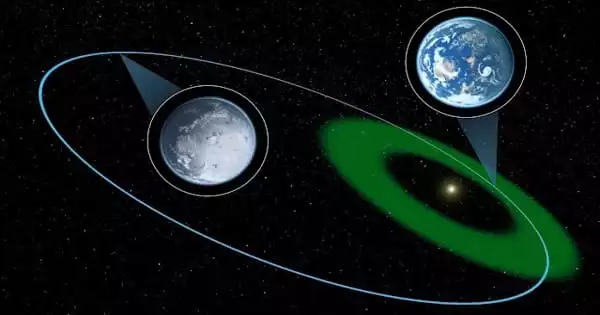A sub-Neptune exoplanet orbiting a red dwarf star has been discovered by an international research team. An international research team led by the University of Bern discovered a sub-Neptune exoplanet orbiting a red dwarf star. The discovery was also made possible by observations made by Mexico’s SAINT-EX observatory. SAINT-EX is managed by a consortium that includes the University of Bern’s Center for Space and Habitability (CSH) and the National Center of Competence in Research NCCR PlanetS.
Small stars, known as “red dwarfs,” are much cooler than our Sun. Liquid water is possible on planets much closer to the star than in our solar system around stars like these. The distance between an exoplanet and its star is critical in its detection: the closer a planet is to its host star, the more likely it will be detected.
Researchers led by Dr. Nicole Schanche of the University of Bern’s Center for Space and Habitability CSH report the discovery of the exoplanet TOI-2257 b orbiting a nearby red dwarf in a study recently published in the journal Astronomy & Astrophysics. Nicole Schanche is also a member of the National Center of Competence in Research PlanetS, which is co-managed by the University of Bern and the University of Geneva.
We discovered that TOI-2257 b does not have a circular, concentric orbit. In fact, it is the most eccentric planet ever discovered orbiting a cool star. TOI-2257 b orbits the host star at a distance where liquid water is possible on the planet, implying that conditions favorable for the emergence of life could exist.
Nicole Schanche
A special telescope is part of the solution
Exoplanets beyond our solar system cannot be observed directly with a telescope because they are too small and reflect too little light. The transit method, on the other hand, is one method for detecting such planets. This entails using telescopes to look for dips in the brightness of a star caused by planets passing in front of it. Repeated observations of the star’s brightness dips provide precise measurements of the planet’s orbital period around the star, and the depth of the transit enables researchers to calculate the planet’s diameter. The planet density can be calculated when combined with estimates of planet mass from other methods, such as radial velocity measurements.
TOI-2257 b was discovered using data from NASA’s Transiting Exoplanet Survey Satellite TESS space telescope. The small star was observed for four months in total, but the gaps between observations made it unclear whether the decrease in brightness could be explained by the transit of a planet with an orbital period of 176, 88, 59, 44, or 35 days.
A subsequent observation of the star with the Las Cumbres Observatory Global Telescope ruled out the possibility that the brightness drop was caused by a planet with a 59-day orbital period. “Next, we wanted to see if the 35-day orbital period was possible,” Nicole Schanche explains.

The SAINT-EX telescope, based in Mexico and co-operated by the CSH and the NCCR PlanetS, was designed specifically to study red dwarfs and their planets in greater detail. The acronym SAINT-EX stands for Search And CharacterIsatioN of Transiting EXoplanets. The project was named after the famous writer, poet, and aviator Antoine de Saint-Exupéry (Saint-Ex). SAINT-EX observed a partial transit of TOI-2257 b and determined the exoplanet’s orbital period around its star to be 35 days. “Another 35 days later, SAINT-EX was able to observe the entire transit, which gave us even more information about the system’s properties,” says CSH co-author and data processor Robert Wells.
A temperate planet with an irregular orbit
TOI-2257 b orbits the host star at a distance where liquid water is possible on the planet, implying that conditions favorable for the emergence of life could exist. Planets in this so-called “habitable zone” near a small red dwarf star are easier to study because their orbital periods are shorter and thus can be observed more frequently. TOI-2257 b’s radius (2.2 times that of Earth) suggests that the planet is rather gaseous, with high atmospheric pressure not conducive to life.
“We discovered that TOI-2257 b does not have a circular, concentric orbit,” Nicole Schanche explains. In fact, it is the most eccentric planet ever discovered orbiting a cool star. “This is bad news in terms of potential habitability,” Nicole Schanche continues. “While the average temperature of the planet is comfortable, it varies from -80°C to about 100°C depending on where the planet is in its orbit, far from or close to the star.” One possible explanation for TOI 2257 b’s unusual orbit is that a giant planet lurks further out in the system, disrupting TOI 2257 b’s orbit. Further observations of the star’s radial velocity will help confirm the eccentricity and look for possible additional planets that could not be seen in transit.
Candidate for observation with JWST
The James Webb Space Telescope (JWST), which launched successfully on December 25, will transform research into exoplanet atmospheres. A transmission spectroscopy metric (TSM) was developed to rank different system properties in order to prioritize good candidates for JWST observations. TOI-2257 b is well placed in relation to TSM and is one of the most appealing sub-Neptune targets for future observations. “The planet could be studied in particular for signs of features such as water vapor in the atmosphere,” Nicole Schanche concludes.





